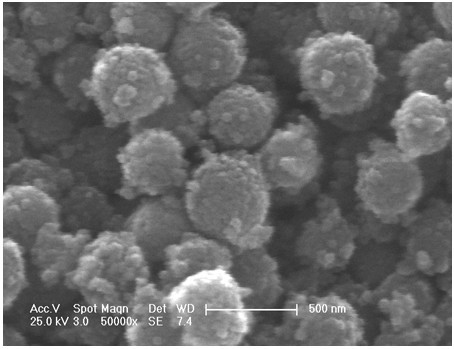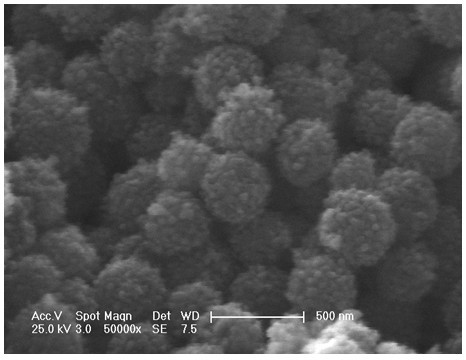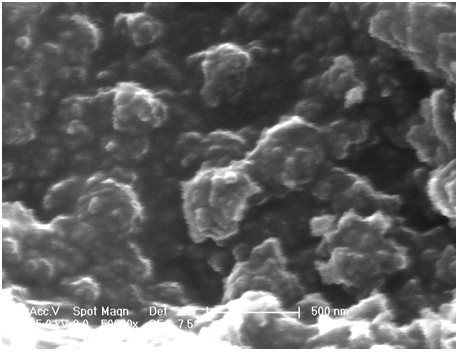Method for preparing bifunctional DSSC (dye-sensitized solar cell) photo-anode
A technology of solar cells and dye sensitization, which is applied in the field of preparation of photoanodes of dual-functional dye-sensitized solar cells, can solve the problems of decreased ability to adsorb dyes, failure to fully utilize, small specific surface area of large particles, etc. The effect of large diameter, increased photoelectric conversion efficiency, and large specific surface area
- Summary
- Abstract
- Description
- Claims
- Application Information
AI Technical Summary
Problems solved by technology
Method used
Image
Examples
Embodiment 1
[0017] Example 1 Preparation of Titanium Dioxide Microspheres of Different Shapes with Different Ammonia Concentrations
[0018] Titanium dioxide microspheres were prepared by hydrolysis-solvothermal method: 0.1 mol / L (mol / liter) KCl aqueous solution was added dropwise to absolute ethanol to make the KCl concentration 4×10 -5 mol / L. Tetrabutyl titanate was added dropwise to the solution, stirred for half an hour, a precipitate formed, and stood for a week. Collect the sediment at the bottom, wash and dry it, and then put it into a hot water ax filled with ammonia, water and ethanol solutions. The mass concentration of ammonia is 28%, and the volume ratios of ammonia, water and ethanol are 0:1:2, 0.05: 1:2, 0.1:1:2, keep warm at 160°C for 16 hours. Collect, wash, and dry at 80°C to obtain titanium dioxide microspheres prepared under three different concentrations of ammonia water.
[0019] The morphology of titanium dioxide microspheres prepared under different ammonia conce...
Embodiment 2
[0020] Example 2 Preparation of bifunctional photoanode and assembly into battery
[0021] Hydrothermal synthesis of nanocrystalline TiO2 slurries (see S. Ito, T. Murakami, P. Comte, P. Liska, C. Gr tzel, M. Nazeeruddin, M. Gr tzel, Thin Solid Films, 516 (2008) 4613- 4619.), coated it on the conductive film (FTO), and annealed at 450-550 ° C for 1 hour to prepare a nanocrystalline titanium dioxide porous film.
[0022] Titanium dioxide microspheres were prepared by hydrolysis-solvothermal method: 0.1 mol / L (mol / liter) KCl aqueous solution was added dropwise to absolute ethanol to make the KCl concentration 4×10 -5 mol / L. Tetrabutyl titanate was added dropwise to the solution, stirred for half an hour, a precipitate formed, and stood for a week. Collect the bottom precipitate, wash and dry it, put it into a hydrothermal ax filled with ammonia water, water and ethanol solution, the volume ratio of ammonia water, water and ethanol is 0.05:1:2, and keep it warm at 160°C for 16 h...
PUM
| Property | Measurement | Unit |
|---|---|---|
| particle diameter | aaaaa | aaaaa |
| particle diameter | aaaaa | aaaaa |
| diameter | aaaaa | aaaaa |
Abstract
Description
Claims
Application Information
 Login to View More
Login to View More - R&D
- Intellectual Property
- Life Sciences
- Materials
- Tech Scout
- Unparalleled Data Quality
- Higher Quality Content
- 60% Fewer Hallucinations
Browse by: Latest US Patents, China's latest patents, Technical Efficacy Thesaurus, Application Domain, Technology Topic, Popular Technical Reports.
© 2025 PatSnap. All rights reserved.Legal|Privacy policy|Modern Slavery Act Transparency Statement|Sitemap|About US| Contact US: help@patsnap.com



